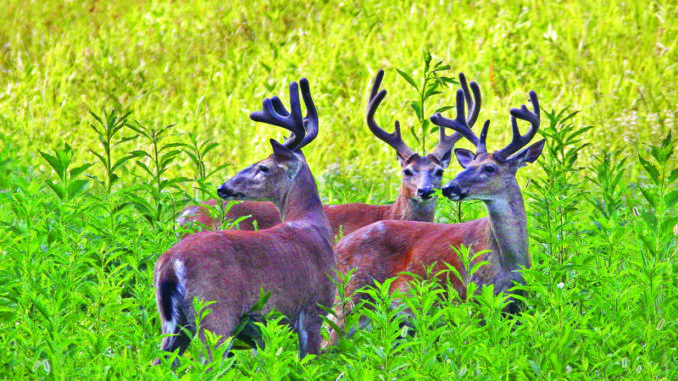
The late-August/early-September period provides hunters not only with the opportunity to take a buck in velvet, but it gives them the opportunity to find and hunt bucks in their “summer” patterns — often ganged up with other bucks.
The term “bachelor group” was coined to describe the way bucks run together during the summer, often in groups of a half-dozen or more. They break up only after rubbing the velvet off their horns and feeling the first surge of hormones that signal the onset of the rut.
“They’re definitely easier to pattern between Aug. 15 and Sept. 1,” said Don Houck of Allendale, who manages a 16,000-acre hunting lease in his home county. “Last year, I had four or five places where I was seeing groups of six to eight bucks — with a 125- to 150-inch buck in each group.
“They’ll stay together until they lose their velvet – usually around the first of September. Then, they’ll still be in little groups, maybe two or three. It’s unusual in September to see four or five deer together.
“But if you’ve got a place where they’re coming into feed, you may have bucks coming in from all directions.”
Houck said bachelor groups of bucks, as well as does, are usually concentrated around major agricultural fields or crops — corn and soybeans top the list — on which they rely to gain the concentrated protein they need while growing antlers.
“Peanuts are planted a little earlier than soybeans,” Houck said. “There’s just as much protein in peanuts as there is in soybeans, and we’ve got 1,100 acres of peanuts. If you’ve got a lot of peanuts or soybeans, early in the season, that’s where they’re going to go.”
Houck advised being very careful about getting too close to those productive fields, even when scouting. That’s where binoculars come in handy.
“Even when they’re in bachelor groups, you can go in and mess ’em up if you get too close,” he said. “They’ll break up and change their pattern. You’ve got to be awfully careful, especially if the group has a real big buck in it.”
Heath Rayfield, who manages the 6,000-acre Buchanan Shoals Sportsman’s Preserve in Chesterfield County and across the state line in North Carolina, likes to use trail cameras around fields or food plots he’s likely to hunt, but he won’t hunt close to his camera locations.
Rayfield is also serious about one huge factor when hunting a nice buck early in the season: scent.
“The biggest thing is scent control,” he said. “Don’t even think of going into a stand to hunt if the wind isn’t right.”
Editor’s Note: This story appears as part of a feature in South Carolina Sportsman’s August issue now on newsstands. To ensure you don’t miss any information-packed issues of the magazine, click here to have each issue delivered right to your mail box.


Be the first to comment